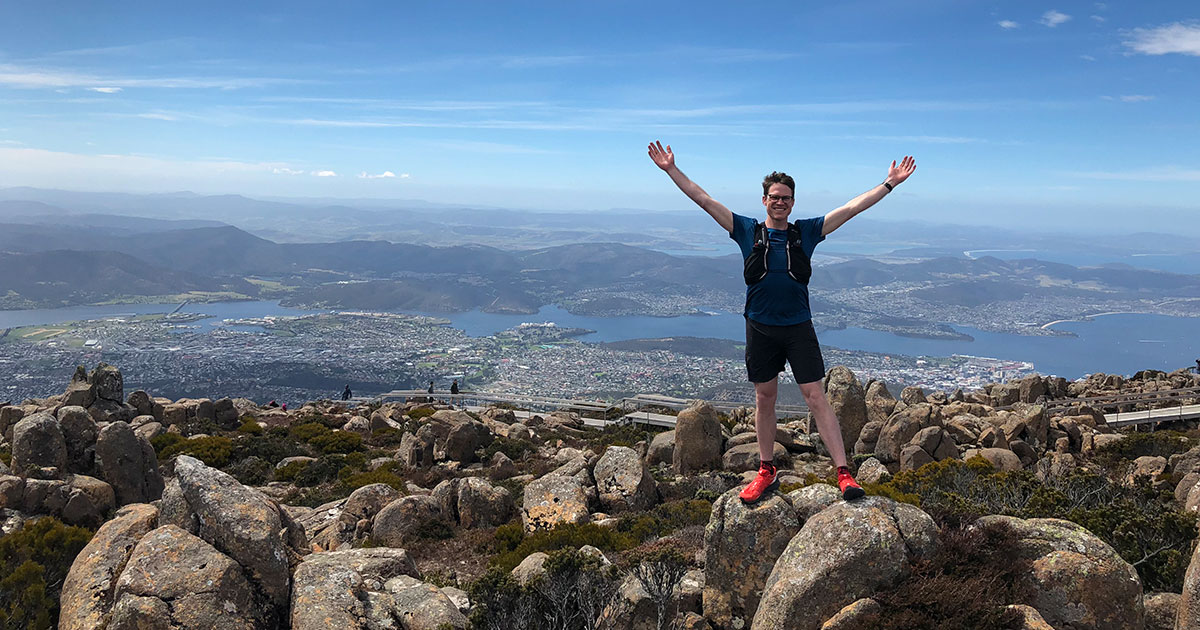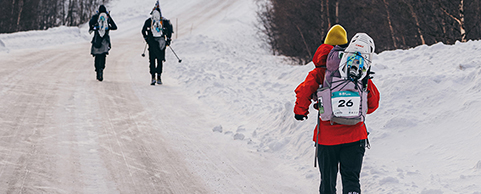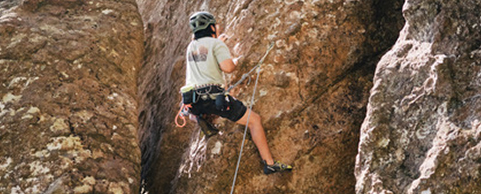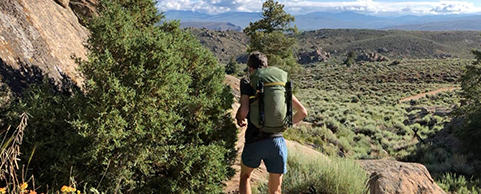Trail Running Belts and Running Vests – How Much Volume Do You Need?

When it comes to running, as people start to increase the duration of their runs – whether that be 5km or 100km – it’s likely they’ll eventually ask themselves something along the lines of: how do I carry extra water? My phone? A snack? Or, if you’re getting into racing, you might be wondering on earth how to carry all that “mandatory gear”.
Let’s look at some of the options available and what they’re used for.
First, some background. For those of you who aren’t familiar with “mandatory gear”, it’s equipment that certain races make you carry for the duration of the event. It’s very common in trail running events, so if you’re transitioning from road running to trail running it’s worth keeping in mind that you’ll probably need to sort yourself out with a bit of extra kit for trail events. The gear is relative to the event – typically you need to carry more the longer the event is, or if it’s particularly remote, or above a certain elevation. So, for a short entry level trail event you might need to carry some water, a phone, and a space blanket for instance. Other events will require considerably more.
Okay, back to the gear.

Running Belts
The most discreet, easiest, and most comfortable option to carry a little bit of extra gear, such as a phone, water bottle and a small snack, is a running belt. My favourite is the Ultimate Direction Utility Belt. I’m still amazed at the amount of stuff I’ve managed to fit into those belt pockets! There is even a dedicated spot to hold your running poles. In addition to using this belt for long training runs, I used to run to the gym and back with it and would routinely (and easily) carry: 500ml water, gym towel, phone, headphones, house keys, a buff and a small snack. It never felt uncomfortable, even loaded to the brim.
Belts come into their own when you’re venturing far enough from home that you need to carry some water, a rain jacket, a snack and keys, but you don’t need to worry about a page-long mandatory gear list. The Utility Belt is one of the larger options as far as belts go, but at 64g it’s not exactly excessive. But for the gram counters among us, if you don’t need as much space as the Utility Belt offers, consider Ultimate Direction’s Comfort Belt (32g) or even Salmon’s S-Lab Modular Belt (17g!).
Running Vests
When you need to start carrying more gear than a belt can accommodate, it’s time to consider a vest. What size vest, though? A common question is this: “I’m only running shorter distances at the moment, but my long-term goal is to run a 100km trail event. Is there any downside to me getting the 100km appropriate vest now and only half-filling it, so that I don’t need to get a smaller volume vest now and a larger volume vest later?” A fair question! The answer is: “Not really…?” Of course, it’s not black and white.
Before I purchased my Utility Belt, I more or less operated in two ways:
- Take nothing with me that I couldn’t comfortably put in the pocket of my running shorts. Normally, just a key to get back into the house, or car.
- Wear my 8L Salomon S-Lab vest.
There’s no real downside to using a vest just to carry a bottle or two of water. Although, you do need to be clever when you use the large back pocket – something small and heavy is prone to bounce around in the excess space back there if it’s not secured in place.
Two considerations: First, after I purchased the Utility Belt (I was sceptical how much use I would get out of it at first) I was kicking myself that I hadn’t done it sooner. As you’ve probably gathered, I’m quite the fan. It gives you that nice middle ground between taking nothing and wearing a vest.
Second, vests are more comfortable than standard backpacks for countless reasons, but one reason is that they use super-light materials. I mean, my 8L Salomon S-Lab vest is 125g! If you’re out on a training run and you trip and fall, it’s not out of the question that you might tear your vest. Further, being so light and close-fitting, a vest is more akin to your running top than a pack. And just as shirts wear out overtime, your vest isn’t going to have the same lifespan as a hiking pack. So, if that 100km event isn’t going to happen for a few years, it might be that you’ll need a new vest by then anyway. Perhaps it might be best to just get one with the capacity you need now, and then upgrade when the time comes if you need to.
People tend to be sceptical about how much they can fit into a vest. “Is 8L really enough to fit all the gear on this awfully long mandatory gear list?” I hear you ask. The answer: “Maybe…” It all depends on what you put in it. If the rain jacket you’re putting in the vest (mandatory gear lists invariably ask for a rain jacket) is the 156g Salomon S-Lab MotionFit 360 GTX Jacket, you’re going to have considerably more room left over than if you try to fit your hiking jacket.
While at first it may seem that getting trail running–specific gear in addition to any other gear you may already have is a bit of a drag, once you’ve been out running for an extended period you’ll appreciate the comfort and weight savings of having the right gear. Fully loaded for a 100km event my vest weighs around 2.4kg – I don’t want it any heavier than that if it doesn’t have to be.

So, can you fit everything you need in an 8L vest for a 100km, assuming you have trail running appropriate gear? The answer is still, “Probably…?” (We’re not getting any clearer, are we?) That’s because not all events ask for the same gear. For instance, here is a picture of my 8L vest packed with (almost) all the mandatory equipment for the UTA100 – the biggest trail running event in Australia. What the UTA100 asks for that not every other 100km event asks for is a 100-weight fleece top, such as the Mont Micro Bushshirt.
The 8L vest can accommodate the fleece, but you’re starting to push the upper limits of what the vest is designed to hold.
Any more gear than this and things would likely start to get a bit unruly. So, depending on just how ultralight your lightweight gear is and what you find comfortable, you may or may not want to go bigger – the Salomon Advanced Skin 12 Set (12L), for instance, or the Ultimate Direction Ultra Vest (10.8L), Ultimate Direction Mountain Vest (13.4L) or Ultimate Direction Adventure Vest (17L).
What capacity running vest is right for you?
As is probably clear by now, there is no one-size-fits-all. Some vests simply aren’t going to hold enough gear for some races, but it seems a little odd to use a 17L Ultimate Direction Adventure Vest simply to carry 500ml of water.

For me, pairing the Ultimate Direction Utility Belt with a Salomon S-Lab 8L vest ticks most of my boxes, although it could fall short in some situations. If your primary events are 100km or more, it’s probably worth looking at vests bigger than 8L. If you’re mostly into events 100km or less, more often than not, an 8L vest is going to be ample (but beware, Salomon S-Lab vests aren’t compatible with hydration bladders! They’re for soft flasks only. So, depending on how much water you need to carry, the Salomon Advanced Skin 12 Set, which can take a bladder, might be more appropriate). If you’re more interested in less-than-ultra events, 8L isn’t necessarily overkill, but you might get by with a 5L vest, depending on the mandatory gear requirements. And for most training runs, unless you’re going somewhere particularly remote and need to carry some safety equipment, belts are the way to go.

Sam McAuliffe,
Bogong Equipment
See our range of trail running gear.
Questions? Visit us, email us or call us (03 9600 0599).
More Articles
- HOW TO FUEL YOURSELF DURING AN ENDURANCE EVENT
- HOW MUCH WATER SHOULD YOU CARRY?
- RUNNING SHOE REVIEW: LA SPORTIVA JACKAL
- MORE RESOURCES...


















